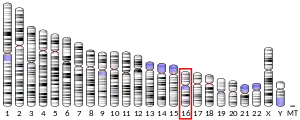Interleukin 32
Interleukin 32 (IL32) is proinflammatory cytokine that in humans is encoded by the IL32 gene.[3] Interleukin 32 can be found in higher mammals but not in rodents. It is mainly expressed intracellularly and the protein has nine different isoforms, because the pre-mRNA can be alternatively spliced.[4][5]The most active and studied isoform is IL-32γ. It was first reported in 2005,[6] although the IL-32 gene was first described in 1992.[7] It does not belong to any cytokine family because there is almost no homology with other cytokines.[5]
mRNA of IL-32 is mostly expressed in immune cells but also can be expressed in other tissues such as spleen, thymus, lung, small intestine, colon, prostate, heart, placenta, liver, muscle, kidney, pancreas and brain.[4][5]
Interleukin 32 is connected with several diseases, including cancer.
Function
This gene encodes a member of the cytokine family. The protein contains a tyrosine sulfation site, 3 potential N-myristoylation sites, multiple putative phosphorylation sites, and an RGD cell-attachment sequence. Expression of this protein is increased after the activation of T-cells by mitogens or the activation of NK cells by IL-2. This protein induces the production of TNF-alpha from macrophage cells. Alternate transcriptional splice variants, encoding different isoforms, have been characterized.[3]
Interleukin 32 (IL-32) is a pro-inflammatory cytokine that can induce cells of the immune system (such as monocytes and macrophages) to secrete inflammatory cytokines, such as tumor necrosis factor-alpha (TNF-α) and IL-6. In addition, it can also induce the production of chemokines such as IL-8 and MIP-2 / CXCL2.[8]
IL-32 can also support osteoclast differentiation but not osteoclast activation by regulating the MAPK/ERK pathway and the actin cytoskeleton.[9]
Cancer
Cancer is often connected with chronic infection and inflammation – they are cause of cancer in 25% of cases. IL-32 plays role in chronic inflammation process and in cancers connected with chronic inflammation (lung cancer, pancreatic cancer, cervical cancer and colon cancer).[10]
IL-32 can be mainly found in cytoplasm of cancer cells. In various cancer tissues, IL32 is highly expressed and presently, the most common isoform of IL-32 found in cancer cells is IL-32β.[11][12]
Function of IL-32 can be very different, depending on its isoform (different isoforms can interact with each other and influence their activities)[5] and type of cell, where it is expressed.
IL-32 supports the tumor progression by cytokines expressed after activation of transcription factor NF-kB (nuclear factor-kB) and by metalloproteinase production. In addition, IL-32 stimulates differentiation into immunosuppressive cell types in some cancer types. These effects of IL-32 support tumor growth. On the other hand, in other cancer types it can also induce tumor cell apoptosis and enhance NK a cytotoxic T cell sensitivity which suppress tumor growth.[11]
References
- GRCh38: Ensembl release 89: ENSG00000008517 - Ensembl, May 2017
- "Human PubMed Reference:". National Center for Biotechnology Information, U.S. National Library of Medicine.
- "Entrez Gene: Interleukin 32".
- Sloot YJ, Smit JW, Joosten LA, Netea-Maier RT (August 2018). "Insights into the role of IL-32 in cancer". Seminars in Immunology. 38: 24–32. doi:10.1016/j.smim.2018.03.004. PMID 29747940.
- Ribeiro-Dias F, Saar Gomes R, de Lima Silva LL, Dos Santos JC, Joosten LA (January 2017). "Interleukin 32: a novel player in the control of infectious diseases". Journal of Leukocyte Biology. 101 (1): 39–52. doi:10.1189/jlb.4RU0416-175RR. PMID 27793959.
- Kim SH, Han SY, Azam T, Yoon DY, Dinarello CA (January 2005). "Interleukin-32: a cytokine and inducer of TNFalpha". Immunity. 22 (1): 131–42. doi:10.1016/j.immuni.2004.12.003. PMID 15664165.
- Dahl CA, Schall RP, He HL, Cairns JS (January 1992). "Identification of a novel gene expressed in activated natural killer cells and T cells". Journal of Immunology. 148 (2): 597–603. PMID 1729377.
- Kim SH, Han SY, Azam T, Yoon DY, Dinarello CA (January 2005). "Interleukin-32: a cytokine and inducer of TNFalpha". Immunity. 22 (1): 131–42. doi:10.1016/j.immuni.2004.12.003. PMID 15664165.
- Mabilleau G, Sabokbar A (2009). "Interleukin-32 promotes osteoclast differentiation but not osteoclast activation". PLOS ONE. 4 (1): e4173. Bibcode:2009PLoSO...4.4173M. doi:10.1371/journal.pone.0004173. PMC 2613539. PMID 19137064.
- Hong JT, Son DJ, Lee CK, Yoon DY, Lee DH, Park MH (June 2017). "Interleukin 32, inflammation and cancer". Pharmacology & Therapeutics. 174: 127–137. doi:10.1016/j.pharmthera.2017.02.025. PMID 28223235. S2CID 26436008.
- Han S, Yang Y (March 2019). "Interleukin-32: Frenemy in cancer?". BMB Reports. 52 (3): 165–174. doi:10.5483/BMBRep.2019.52.3.019. PMC 6476484. PMID 30638183.
- Yan H, He D, Huang X, Zhang E, Chen Q, Xu R, et al. (July 2018). "Role of interleukin-32 in cancer biology". Oncology Letters. 16 (1): 41–47. doi:10.3892/ol.2018.8649. PMC 6006503. PMID 29930712.
This article incorporates text from the United States National Library of Medicine, which is in the public domain.

